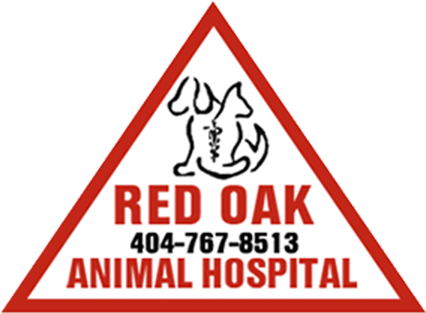Environmental, Atopic Allergies
Environmental allergies are the most common cause of itchiness in pets – far exceeding food allergies and parasites in this area of the country. Dogs manifest allergies through itchy skin (most notably by chewing the paws), hot-spots, anal gland issues, and infections of the ears, skin and/or feet. Some dogs also develop mucus eye discharge and redness (lymphoid follicular conjunctivitis), but dogs rarely will have congestion, coughing or sneezing as is seen in humans. Cats manifest through itchy skin and can develop eosinophilic granuloma ulcers on their lips, underside of the belly and legs, as well as miliary dermatitis with small pustules/rash all over the body. Environmental allergies can be year-round due to things like dust and storage mites, but often they will flare in the early spring and fall, while improving in the winter.
Testing:
There is a blood test that can help determine the cause of your pets’ environmental allergies that can be done through our hospital. If negative, this test can help rule out environmental allergies as well. To determine if secondary infections are present, skin cytology is commonly performed in any area that has evidence of skin disease. More advanced intradermal allergy testing is also available, but this is performed by a board-certified veterinary dermatologist; we will let you know if we think your dog or cat should have a referral for this test.
Treatment:
- Immunotherapy: This is the only treatment that can eventually train your dog’s immune system to stop reacting to the allergens. This therapy is formulated specifically for your dog based on the results of the allergy test and involves giving them very small amounts of the allergen in a controlled fashion over long periods of time. Immunotherapy can be given by periodic injections at home or through a daily sublingual (oral) drop. Immunotherapy must be given for a minimum of 12 – 15 months to determine effectiveness and would be continued lifelong if effective. Immunotherapy works for roughly 50% of patients and the goal is to be able to gradually stop or reduce all other medications needed to control symptoms. Although complete resolution of allergic disease is the goal, some dogs experience only partial resolution.
- Anti-itch medications: Medications are used to suppress the itchiness caused by allergies and, by reducing skin inflammation, they result in less infections.
- Cytopoint (CADI) Injections (Dog Only) – a safe and effective, but expensive, option for reducing itchiness and inflammation of the skin with minimal to no suppression of the overall immune system. This is considered the gold standard for allergy relief in dogs. Injections are typically given every 4-6 weeks either year-round or during the allergy season.
- Apoquel – a safe and effective, but expensive, oral medication typically given once to twice a day that is used to reduce itchiness and infection with similarly minimal suppression of the immune system. This can be given year-round or only as needed and can be started and stopped anytime. This medication is used extra label in cats and is also found to be safe and effective.
- Steroids – an effective and inexpensive option coming in several forms (sometimes combined with an antihistamine) to be used for short term allergy relief. Long-term or high-dose use of steroids tends to result in unwanted side effects and suppresses the overall immune system and the ability to fight infections. Cats are less susceptible to side effects but must use prednisolone, not prednisone. Steroids are a mainstay in allergy relief for cats, but if needed at high doses and year-round – other options are better.
- Antihistamines – over the counter antihistamines are effective for only a small percentage of dogs (~20%). However, because they are inexpensive, safe and readily available, many owners choose to try antihistamines as part of their dog’s therapy. Cats typically respond more favorably, and antihistamines are a common part of cat allergy relief.
- Cyclosporine (Atopica) – an expensive immune suppressant that poses higher risk but is generally safe and effective. Used typically as a last resort in dogs because of the expense, the long time it takes to work, and the risk of side effects. However, this medication is more cost effective in cats and is used frequently in significant allergic cats who require year-round treatment.
- Topical medications: These include sprays, shampoos, soaks, mousses, and ointments. Many dogs will benefit from a topical regiment targeted to their most sensitive allergen areas. For example, dogs that suffer from recurrent ear infections may benefit from a topical cleanser and an ointment used in the ears regularly to reduce the risk of infection. Other examples would include certain anti-itch baths or foot soaks designed to soothe the skin, reduce itchiness and lower the risk of infection. Finally, topical products are pivotal in treating infections around the body if present and work synergistically with oral antifungals or antibiotics. We will help determine if your pet would benefit from topical therapy.
- Supplements: Dogs and Cats with atopic allergies are known to benefit from high doses of fish oil supplements and/or probiotics. Fish oils must be given in a highly concentrated amount to see any clinical benefit and many companies do not provide therapeutic levels. We will help you determine what, if any supplements, may help your pet. Further, many foods designed for sensitive skin will have supplements built into the diet.
- Diets: Even if food allergies have been ruled out as a cause of your pets’ itchiness, there are prescription therapeutic diets designed to help restore your pets skin barrier health and reduce itchiness. These diets incorporate highly concentrated fish oils as well as other nutritional means to help your pet. Please ask if a prescription diet is ideal for your pet.
